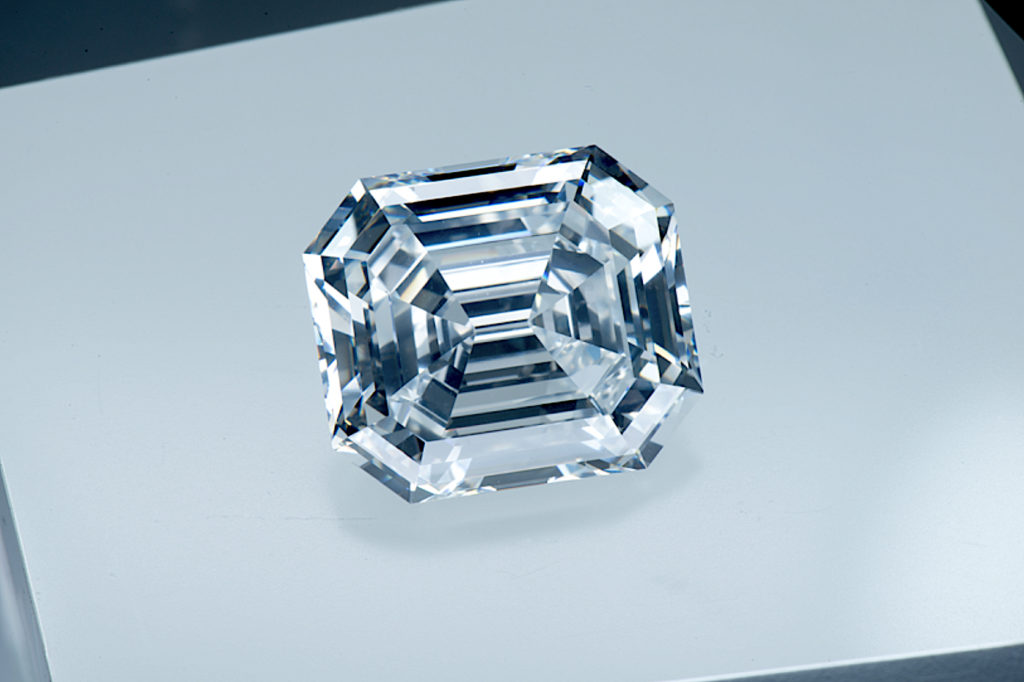Los Angeles’ Natural History Museum is mounting a super-duper show in Exposition Park through the spring.
The museum recently unveiled “100 Carats: Icons of the Gem World,” an exhibition of some of the highest quality rare gems on earth, including the world-famous Jonker I diamond, which has not been viewed publicly for decades.
“Right this way!” you can almost hear the carnival barker’s cry.
Says Lori Bettison-Varga, the museum’s president and director: “Gems of such magnificent size and quality have never been displayed before in this quantity in one exhibition.”
The 125-carat Jonker I, one of the largest cut diamonds in the world, is the centerpiece of the exhibition.
The Jonker, found by a South African farmer in 1934, was at the time the fourth-largest uncut gem ever discovered. At 726 carats — a little over five ounces — it was later cut into 13 smaller stones, the Jonker I being the largest.
Far more interesting than the stone’s size, to my mind, is the intrigue surrounding it.
From Wikipedia: “In 1949, King Farouk of Egypt purchased the Jonker I, but after he was deposed and exiled in 1952, the gem was lost. After a number of years, the gem reappeared in the ownership of Queen Ratna of Nepal. The last known location of the Jonker I was in Hong Kong in 1977 when it was sold to an anonymous buyer for $2,259,000.”
Lost? Wouldn’t you give anything to know how the gem made its way from Egypt to Nepal? Whoever the anonymous buyer was in 1977, today the Jonker I is owned — and on loan to the NHS — by Ibrahim Al-Rashid. No further details given.
In its 80 years of existence, the diamond has never been on display in a museum. Which just goes to show, really, what can you do with this exquisite jewel except put it in a safe?

Stained-glass windows depicting the Parable of the Hidden Treasure (left) and the Parable of the Pearl (right) in Scots’ Church, Melbourne. (Wikimedia Commons)
But the exhibition includes way more than the Jonker I. Other treasures include a 241-carat emerald known as “The Crown of Colombia,” a deep aquamarine beryl called “The Northern Light,” an exquisite blood-red rubellite tourmaline, “The Princess Pink Sapphire,” and “The Ukrainian Flag Topaz.” Every stone in the exhibit is at least 100 carats (a carat weighs .007 of an ounce), which in the gem world is gigantic.
“Every gem is a minor geologic miracle,” the museum notes.
Think mountains, volcanoes, tectonic plates, and mysterious movements deep within the earth’s surface. After millions of years, these brilliant, sparkling gems emerge (helped along by master cutters, polishers, and jewelry designers like Robert Procop, who figures prominently in the exhibit).
But gems also have a sinister side. They’re mostly worn by women. At this level, they’re insanely expensive: in 2015, a “perfect” 100-carat diamond sold at Sotheby’s for $22 million. Put the two together and mayhem, at some point, is bound to result.
Having spent most of my own unglamorous life reading rather than boning up on carats, the phrase “iconic gems” evokes any number of juicy stories, novels, and films where the lust for jewels has led to ruin.
Anthony Trollope’s 1871 novel “The Eustace Diamonds,” for example, in which gold digger and pathological liar Lizzie Greystock marries the sickly Sir Florian Eustace knowing he will soon die and leave her a wealthy widow. The diamonds are a family heirloom that Lizzie coolly refuses to relinquish. Romantic hijinks and interminable litigation ensue, the upshot being that Lizzie, satisfyingly, gets just what she deserves.
Guy de Maupassant’s 1884 short story “The Necklace” is a cautionary tale about a woman who disdains her loving, faithful husband and prefers to live in fantasy. When they’re invited to a fancy ball, she borrows an expensive diamond necklace from a friend, a move that results in one night of ecstasy and a lifetime of abject misery.
That’s not even counting the German-born film director Max Ophuls’ “The Earrings of Madame de…” (1953), a romantic drama that ends with a duel and an implied suicide.
But far be it for me to be a wet blanket.
The once-in-a-lifetime show runs through April 21. So go. Ooh and aah at these wonders of nature. Gasp at the brilliance, the vivid colors, the perfection. Ponder the fact that such gems occur nowhere else in the solar system.
Let’s not forget, however, that Jesus also knew about jewels. “Again, the kingdom of heaven is like a merchant seeking beautiful pearls, who, when he had found one pearl of great price, went and sold all that he had and bought it” (Matthew 13:45–46).
Here’s the distinction: the kingdom of heaven is not reducible to a stone. The kingdom of heaven, for which we’re willing to give up everything we own, can’t be bartered, bought, traded or sold. It’s beyond price.
And you never have to keep it in a safe.

